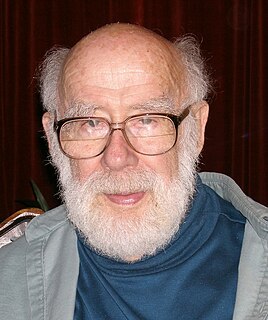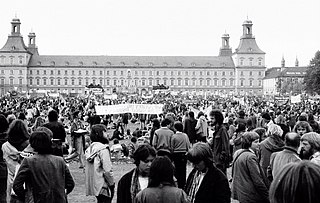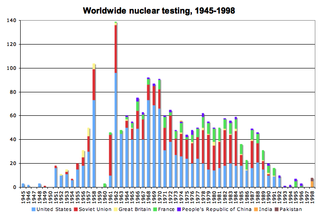Related Research Articles

The organized environmental movement is represented by a wide range of non-governmental organizations or NGOs that seek to address environmental issues in the United States. They operate on local, national, and international scales. Environmental NGOs vary widely in political views and in the ways they seek to influence the environmental policy of the United States and other governments.

Nuclear disarmament is the act of reducing or eliminating nuclear weapons. It can also be the end state of a nuclear-weapons-free world, in which nuclear weapons are completely eliminated. The term denuclearization is also used to describe the process leading to complete nuclear disarmament.

The United States Atomic Energy Commission, commonly known as the AEC, was an agency of the United States government established after World War II by U.S. Congress to foster and control the peacetime development of atomic science and technology. President Harry S. Truman signed the McMahon/Atomic Energy Act on August 1, 1946, transferring the control of atomic energy from military to civilian hands, effective on January 1, 1947. This shift gave the members of the AEC complete control of the plants, laboratories, equipment, and personnel assembled during the war to produce the atomic bomb.

The Natural Resources Defense Council (NRDC) is a United States-based 501(c)(3) non-profit international environmental advocacy group, with its headquarters in New York City and offices in Washington D.C., San Francisco, Los Angeles, New Delhi, Chicago, Bozeman, and Beijing. Founded in 1970, the NRDC has over 3 million members, with online activities nationwide, and a staff of about 700 lawyers, scientists and other policy experts.

The Pugwash Conferences on Science and World Affairs is an international organization that brings together scholars and public figures to work toward reducing the danger of armed conflict and to seek solutions to global security threats. It was founded in 1957 by Joseph Rotblat and Bertrand Russell in Pugwash, Nova Scotia, Canada, following the release of the Russell–Einstein Manifesto in 1955.

Helen Mary Caldicott is an Australian physician, author, and anti-nuclear advocate. She founded several associations dedicated to opposing the use of nuclear power, depleted uranium munitions, nuclear weapons, nuclear weapons proliferation, and military action in general.

John William Gofman was an American scientist and advocate. He was Professor Emeritus of Molecular and Cell Biology at University of California at Berkeley.

The anti-nuclear movement is a social movement that opposes various nuclear technologies. Some direct action groups, environmental movements, and professional organisations have identified themselves with the movement at the local, national, or international level. Major anti-nuclear groups include Campaign for Nuclear Disarmament, Friends of the Earth, Greenpeace, International Physicians for the Prevention of Nuclear War, Peace Action and the Nuclear Information and Resource Service. The initial objective of the movement was nuclear disarmament, though since the late 1960s opposition has included the use of nuclear power. Many anti-nuclear groups oppose both nuclear power and nuclear weapons. The formation of green parties in the 1970s and 1980s was often a direct result of anti-nuclear politics.

The anti-nuclear movement in the United States consists of more than 80 anti-nuclear groups that oppose nuclear power, nuclear weapons, and/or uranium mining. These have included the Abalone Alliance, Clamshell Alliance, Committee for Nuclear Responsibility, Nevada Desert Experience, Nuclear Information and Resource Service, Physicians for Social Responsibility, Plowshares Movement, Women Strike for Peace, and Women's International League for Peace and Freedom. The anti-nuclear movement has delayed construction or halted commitments to build some new nuclear plants, and has pressured the Nuclear Regulatory Commission to enforce and strengthen the safety regulations for nuclear power plants.
The 1970s proved to be a pivotal period for the anti-nuclear movement in California. Opposition to nuclear power in California coincided with the growth of the country's environmental movement. Opposition to nuclear power increased when President Richard Nixon called for the construction of 1000 nuclear plants by the year 2000.
Anti-nuclear organizations may oppose uranium mining, nuclear power, and/or nuclear weapons. Anti-nuclear groups have undertaken public protests and acts of civil disobedience which have included occupations of nuclear plant sites. Some of the most influential groups in the anti-nuclear movement have had members who were elite scientists, including several Nobel Laureates and many nuclear physicists.

A peace movement is a social movement that seeks to achieve ideals such as the ending of a particular war, minimize inter-human violence in a particular place or type of situation, and is often linked to the goal of achieving world peace. Means to achieve these ends include advocacy of pacifism, non-violent resistance, diplomacy, boycotts, peace camps, moral purchasing, supporting anti-war political candidates, legislation to remove the profit from government contracts to the military–industrial complex, banning guns, creating open government and transparency tools, direct democracy, supporting whistleblowers who expose war crimes or conspiracies to create wars, demonstrations, and national political lobbying groups to create legislation. The political cooperative is an example of an organization that seeks to merge all peace movement organizations and green organizations, which may have some diverse goals, but all of whom have the common goal of peace and humane sustainability. A concern of some peace activists is the challenge of attaining peace when those that oppose it often use violence as their means of communication and empowerment.
Students for a Libertarian Society (SLS) was an activist organization for students in the United States seeking to promote libertarian ideals on college campuses. Currently active libertarian student groups include Students for Liberty and Young Americans for Liberty.

More than 80 anti-nuclear groups are operating, or have operated, in the United States. These include Abalone Alliance, Clamshell Alliance, Greenpeace USA, Institute for Energy and Environmental Research, Musicians United for Safe Energy, Nevada Desert Experience, Nuclear Control Institute, Nuclear Information and Resource Service, Public Citizen Energy Program, Shad Alliance, and the Sierra Club. These are direct action, environmental, health, and public interest organizations who oppose nuclear weapons and/or nuclear power. In 1992, the chairman of the Nuclear Regulatory Commission said that "his agency had been pushed in the right direction on safety issues because of the pleas and protests of nuclear watchdog groups".

Conservation Fallout: Nuclear Protest at Diablo Canyon is a 2006 book by John Wills.

Beginning as a conservation movement, the environmental movement in Australia was the first in the world to become a political movement. Australia was home to the world's first Green party.
During the Cold War (1947–1991), when the Soviet Union and the United States were engaged in an arms race, the Soviet Union promoted its foreign policy through the World Peace Council and other front organizations. Some writers have claimed that it also influenced non-aligned peace groups in the West, although the CIA and MI5 have doubted the extent of Soviet influence.(citation needed)

The application of nuclear technology, both as a source of energy and as an instrument of war, has been controversial.

An anti-war movement is a social movement, usually in opposition to a particular nation's decision to start or carry on an armed conflict, unconditional of a maybe-existing just cause. The term anti-war can also refer to pacifism, which is the opposition to all use of military force during conflicts, or to anti-war books, paintings, and other works of art. Many activists distinguish between anti-war movements and peace movements. Anti-war activists work through protest and other grassroots means to attempt to pressure a government to put an end to a particular war or conflict or to prevent it in advance.
References
- 1 2 3 Jerome Price (1982). The Anti-nuclear Movement, Twayne Publishers, pp. 78-79.
- ↑ John W. Gofman, "Irrevy" - An irreverent illustrated view of nuclear power, Committee for Nuclear Responsibility, 1979
- ↑ "John Gofman (USA)". Archived from the original on 2008-11-22. Retrieved 2010-03-23.